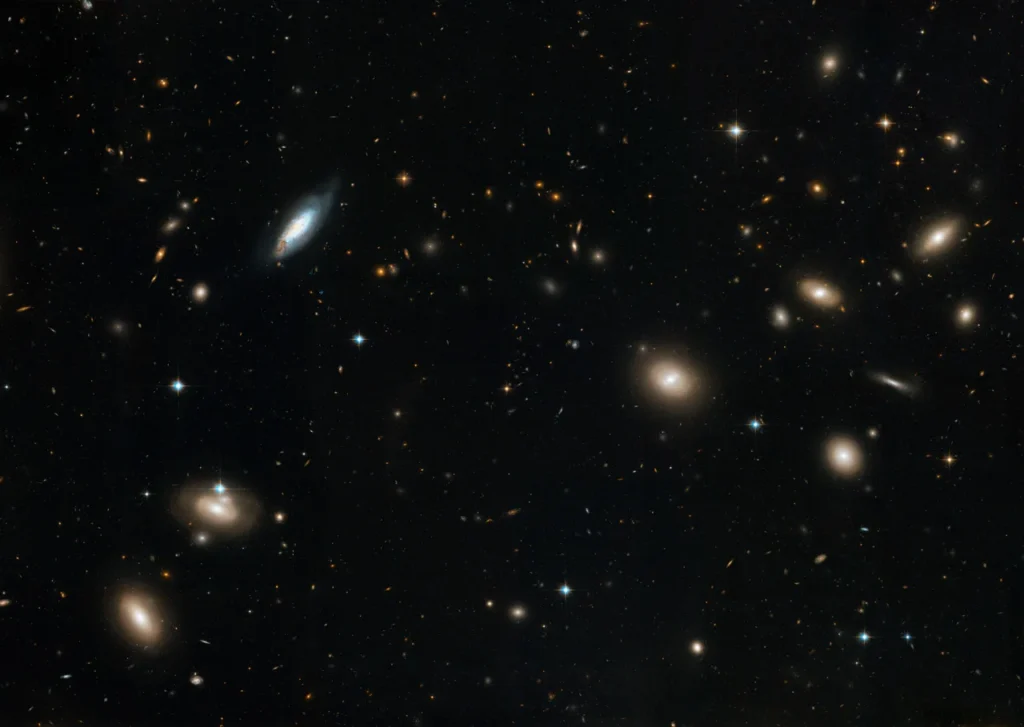Dark matter is a mysterious substance that fills the universe. Even though we can’t see it, we know it’s there because of its gravitational pull on stars and galaxies.
It makes up about 27% of the universe’s mass. Dark matter behaves differently from regular matter, and scientists are still trying to figure out exactly what it is. Another puzzling part of the universe is dark energy, which makes up about 68% of everything.
Dark matter and dark energy collectively constitute nearly 95% of the universe. Studying these invisible forces aids in comprehending the functioning of the universe despite the significant mystery they present.
What is dark matter, and why is it important?

Dark matter remains a theoretical construct in astronomy, inferred from gravitational effects that cannot be accounted for by visible matter alone. In the lambda-CDM model, dark matter comprises 26.8% of the universe’s mass energy, vastly surpassing ordinary matter. Despite its prevalence, dark matter’s elusive nature makes it challenging to directly observe or interact with in laboratory settings.
Dark matter may be composed of undiscovered particles (like WIMPs or axions) or primordial black holes, according to the leading explanation. Various classifications such as “cold,” “warm,” or “hot” describe dark matter based on its velocity characteristics.
The majority of astrophysicists accept the existence of dark matter. However, a minority proposes alternative theories, such as modified Newtonian dynamics or tensor-vector-scalar gravity, to explain observed phenomena.
Although none of these theories have successfully accounted for all observational evidence, modifications to gravity may still be warranted. However, dark matter likely still plays a crucial role in our understanding of the universe’s structure and dynamics.
How does dark matter’s energy density scale with the universe’s expansion?

In cosmology, when we talk about “matter,” we’re referring to anything in the universe that has mass and affects its overall density. This includes things like stars, planets, and gas clouds. Matter behaves in a certain way as the universe expands—it becomes less dense over time.
On the other hand, “radiation” refers to things like light and other forms of energy that travel through space. As the universe expands, the energy of radiation decreases because the wavelengths of light stretch out.
Now, when we talk about “dark matter,” we’re talking about something invisible that still has mass. It behaves similarly to regular matter as the universe expands, meaning its density decreases over time. But here’s the catch: when we say “dark matter,” we’re usually talking about the stuff that’s not made of regular atoms, like protons and neutrons. Instead, it could be made up of exotic particles that we haven’t directly detected yet.
However, there’s also something called “missing baryons,” which refers to regular matter that we can’t see directly. This could be because it’s too faint or too spread out to detect with telescopes.
Sometimes ‘dark matter’ refers to all unseen mass, other times specifically to enigmatic non-atomic substances within the universe.
In conversations about the universe, the meaning of “dark matter” usually depends on the context. Understanding mass and energy’s role shapes the evolving cosmos, whether discussing invisible matter or the non-atom-based variety.
What are some proposed origins of dark matter?

Dark matter is like a cosmic puzzle piece that scientists are still trying to fit into our understanding of the universe. Gravitational effects on visible matter reveal its presence, yet its nature and origin remain enigmatic, leaving profound questions unanswered.
One idea is that dark matter dates back to the beginning of the universe, the Big Bang. When the universe was super hot and dense, particles were flying around like crazy. Some theories suggest that among these particles were ones we now call dark matter.
As the universe expanded and cooled, these dark matter particles spread out, forming a kind of invisible cosmic web. This web might be why galaxies clump together in certain places, where strands of dark matter intersect.
Another fascinating theory suggests that black holes could be hiding lots of dark matter. Black holes are like cosmic vacuum cleaners—they suck in everything around them, even light. Some scientists think that dark matter might get trapped inside black holes, making them invisible repositories for this mysterious substance.
But it’s not just black holes. Other cosmic leftovers, like white dwarfs, neutron stars, and brown dwarfs, could also be hoarding dark matter within their gravitational grasp.
The thing is, dark matter opens up a whole new realm of questions and possibilities for astrophysicists and cosmologists. Figuring out its origins and properties could revolutionize our understanding of the universe. Scientists are hard at work, using telescopes and experiments to shine a light on dark matter. Yet, even though we’re still in the dark about it, they persist in their efforts to unravel this cosmic enigma.
What pivotal evidence supported the existence of dark matter?

The hypothesis of dark matter has a rich history dating back to the late 19th century. Lord Kelvin’s discussions in 1884, based on observations of star velocities near the Sun, hinted at the presence of numerous unseen celestial bodies. He speculated that there might be a vast number of stars within a certain distance from the Sun. Many of them could be dark and therefore invisible.
In 1906, Henri Poincaré coined “matière obscure” (dark matter) to explain the unseen mass hinted at by Kelvin’s research. This early speculation laid the groundwork for future investigations into the nature of dark matter.
In the 1920s and 1930s, astronomers proposed dark matter to explain galactic motion discrepancies, independently discovering its potential existence.
Jacobus Kapteyn, Knut Lundmark, Jan Oort, and Fritz Zwicky all contributed to this growing body of evidence. In 1933, Zwicky’s work, in particular, provided compelling evidence for the presence of an unseen mass in the Coma Cluster. This discovery led him to coin the term “dunkle Materie” (dark matter).
The 1960s and 1970s saw significant advancements in observational techniques, particularly in radio astronomy. Astronomers like Seth Shostak, Vera Rubin, Kent Ford, and Ken Freeman conducted pioneering studies of galaxy rotation curves.
These studies revealed that galaxies contained far more mass than could be explained by the visible matter alone. These findings provided strong empirical support for the existence of dark matter.
By the 1980s, a diverse array of observational evidence bolstered the case for dark matter. Gravitational lensing, temperature distribution of hot gas, and cosmic microwave background anisotropies indicate unseen mass.
These phenomena suggest cosmic-scale gravitational effects. Cosmologists increasingly converged on the idea that dark matter is primarily composed of yet-to-be-discovered subatomic particles.
Overall, the history of dark matter reflects a gradual accumulation of evidence from various astronomical observations, spanning over a century. Despite its elusive nature, this evidence has led to the widespread acceptance of dark matter as a fundamental component of the universe.
The ongoing search for the elusive particles constituting dark matter remains one of the forefront challenges in both astrophysics and particle physics.
FAQ’s
What is dark matter in simple terms?
Dark matter is a mysterious substance that doesn’t interact with light like normal matter does. It doesn’t absorb, reflect, or emit light, making it incredibly difficult to detect. Scientists infer its existence from the gravitational effects it has on visible matter, even though they’ve never directly observed it.
Is dark matter a reality?
Yes, dark matter is indeed a reality. It constitutes over 80% of all matter in the universe, yet scientists have never directly observed it. Dark matter’s gravitational effects on visible matter justify its existence, as stellar, planetary, and galactic behaviors would otherwise lack coherence.
Final Words
Dark matter and dark energy are like the cosmic shadows we’re still trying to shine a light on. Even though we can’t see them, they play crucial roles in shaping the universe.
Their mysterious nature challenges scientists to uncover their secrets, leading to discoveries about the cosmos. Studying dark matter and dark energy unveils the universe’s mysteries, illuminating its past, present, and future with profound insights.
